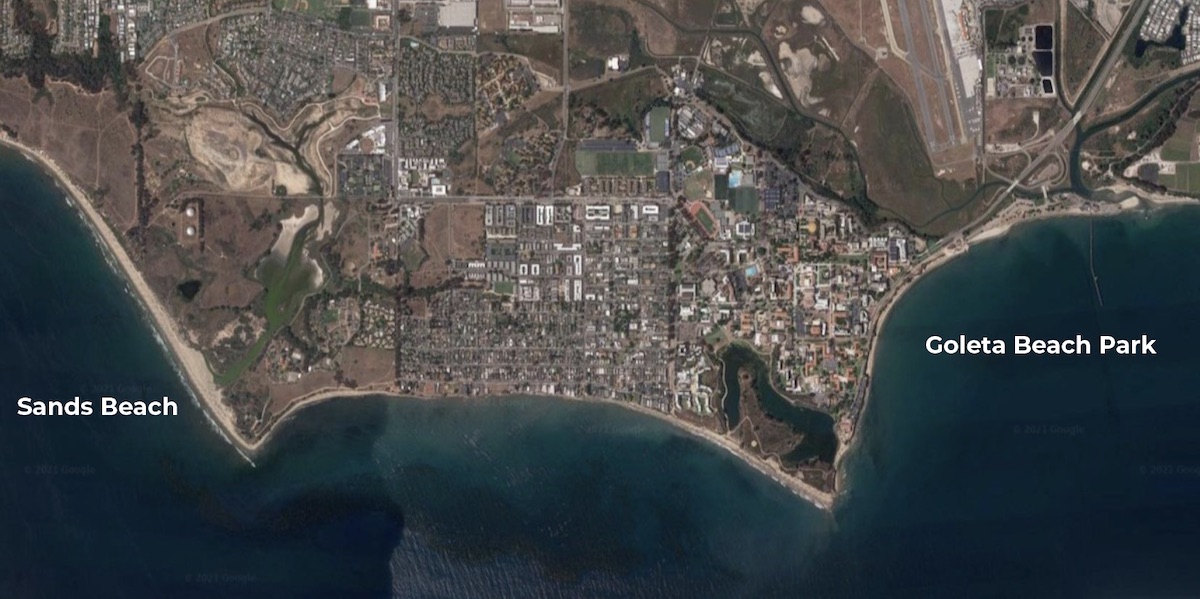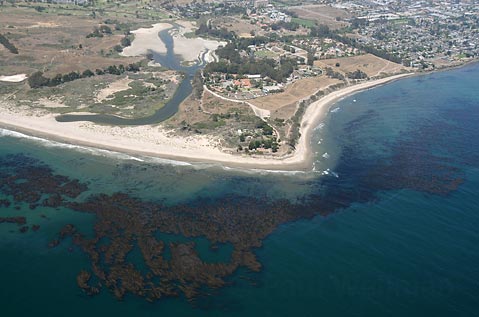Saving Goleta Beach Park
What to Do About the Inexorable Erosion?

So, what to do about the inexorable erosion of Goleta Beach Park?
People first came to live in the land that we now call Goleta about 13,000 years ago. At that time the coast was littered with wide and productive estuaries at the mouth of every drainage that flowed out of the Santa Ynez Mountains from Carpinteria to Hollister Ranch. They lived simple and rich lives from the shellfish easily gathered from the estuaries and the small seeds from the chaparral plants on the nearby shore. The sea levels were low, due to all the glaciation to the north; the canyons out of the mountains were deep and broad, all the way to the sea, where they formed the productive habitats on which the progenitors of the Chumash lived and thrived.
The glaciers melted. The sea levels rose. The estuaries were inundated. Things changed, and the people living in these spaces changed their habits.
They moved inland. They invented boats and spears and bows and arrows. They hunted pelagic fish and ocean-thriving mammals as well as land-thriving mammals. When the number of small seeds diminished, they learned to eat acorns from the oak trees and then learned if they conducted fires in the wild lands more oak trees would grow and provide more acorns. They learned how to seal baskets with tar from the beach in order to transport water longer distances. They learned to live on hills rather than in creek bottoms. They learned to trade with their neighbors, exchanging what they had in abundance for the surplus that their neighbors enjoyed.
When the ocean levels rose, they adapted in many different ways. One thing they did not do is attempt to hold back the sea. They endured and thrived until the Europeans discovered them. But that is another story, a sad one.
The Europeans, on the other hand, have a history of engineering bulwarks against the depredations of nature. Romans built aqueducts to transport water over great distances. The Dutch and the Italians built entire cities in what were wetlands. Rivers were tamed, seas were held back, water was transported from places where it was abundant to places where it was scarce.
Huge amounts of human energy and capital were expended to make unlivable spaces livable. Human engineering of the environment became a successful and dominant paradigm. Rightly so. Here we are — nearly 8 billion people living on the Earth, skyscrapers in cities of millions of people. We have walked on the moon, our tools are scuttling about on Mars, I can write an email to a friend in Turkey tonight and read his reply the next morning. All wonderful.
But still, when the sea rises, it is inexorable. Sooner or later, it will defeat all our attempts to push it back. It does not feel exhaustion. It does not practice engineering. It simply rises and rises and rises and covers all in its path. It does not laugh at our short-term victories against it. It simply presses on with a persistence and patience that you could cite in a self-help book as a model of success. A rising sea will not be denied.
The sandbar strand that forms Goleta Beach Park has always been fragile to the ever-changing whims of the Pacific Ocean and to the amount of sand that is deposited from the Santa Ynez Mountains through the Goleta Slough and the sand flowing down from the drainages to the west. Not that long ago, where the Santa Barbara Airport sits was a large deep-water bay, the mouth of which was a large estuary. The true influence of the ocean goes all the way to what is now Hollister Avenue.

We just do not think about it. In hindsight, all the infrastructure that has been built on that sand bar has been a rather short-sighted endeavor. In the short term we can protect those investments with revetments along the shrinking shoreline. But boulders on the beach will not stop the ocean. You might as well spit into a strong wind. Furthermore, revetments are notorious for resulting in the scouring of sand from the beach front, which would ultimately result in Goleta Beach Park having no beach.
The engineering term “nourishment” sounds so promising until you dive into its definition. It means transporting millions of tons to sand to Goleta Beach from somewhere else at untold costs, both in terms of monetary outlay and pollution; a cost that would go on forever. Is that really a solution?
If not, what is the solution? If you look at human history, it appears hopeless. There are nearly 7.7 billion people on the Earth. The vast majority of us are so poor as to have no political agency that would enable us to produce meaningful change on a global scale. On the other side, there are many of us who are so rich that we would never use our agency to intentionally inflict change that does not suit our comfort. This is not a recipe for change.
However, in the case of Goleta slough, there is hope. The Goleta slough is a deep and rich estuary, despite all the fill that has occurred at the airport. Just as the Devereux slough remains a deep and rich one despite the development that has occurred around it.

Take a walk out to Sands Beach on the western and windward side of Coal Oil Point. There exists a dynamic sand dune strand that changes over time but endures without human interference or engineering. It provides not only a viable natural habitat for many species but also ample recreational opportunity for thousands of people. The sands ebb and flow the coastline profile changes. Yet, there it is year after year and nobody seems concerned about its future. The sea will rise (apparently, we humans are unwilling to change our behaviors enough to reverse this inevitable outcome), and the sands of Sands Beach will shift and ebb and retreat and charge, and there it will be, year after year, different and the same, without engineering, without a plan, with no human input of energy whatsoever.
The solution may be staring us in the face, right around the corner from Goleta Beach.
Editor’s Note: Regarding Sands Beach, Cristina Sandoval, the director of the Coal Oil Point Reserve located there, makes a request: If people approach Sands Beach, please realize the beach, and especially the dunes, are highly sensitive habitat with a population of a threatened bird, the Western Snowy Plover. An overuse of the area for recreation is already causing problems in the reserve’s ability to protect the plovers from disturbance, trespassing, and dogs off-leash. For active recreation and sunbathing, please use other beaches. Please keep dogs on a leash at Sands Beach to avoid disturbing nesting and feeding birds. Please remain within the corridor, the area between the plover fence and the ocean, for walking, ideally at the water’s edge. The flightless plover chicks feed in this area, and they close their eyes and duck down when people approach, making them nearly invisible. To avoid stepping on them accidentally, please walk near the ocean’s edge. To watch plover chicks and nests, ask a docent to point them out to you. They are very adorable. Watch plovers at COPR in our free videos at https://copr.nrs.ucsb.edu/media/videos.




You must be logged in to post a comment.